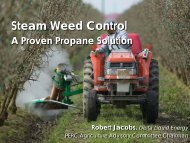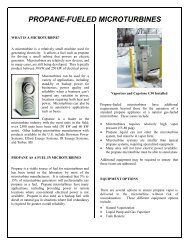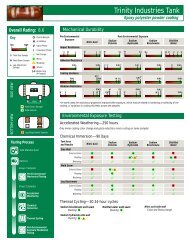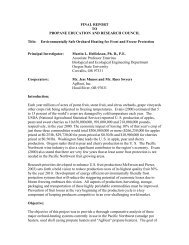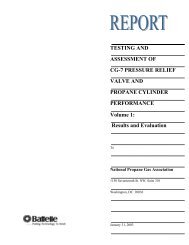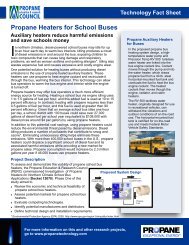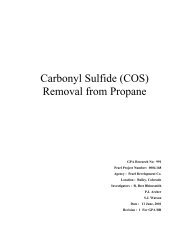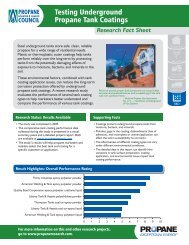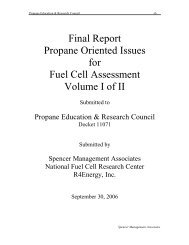Code Approval of Composite Propane Cylinders for Indoor Use ...
Code Approval of Composite Propane Cylinders for Indoor Use ...
Code Approval of Composite Propane Cylinders for Indoor Use ...
You also want an ePaper? Increase the reach of your titles
YUMPU automatically turns print PDFs into web optimized ePapers that Google loves.
lower joint. The failure mechanism appears to be that the vapor space in the cylinder does notkeep the wall cool enough to prevent the joint from coming apart. Under similar conditions,the other cylinder design did not rupture.• Twenty <strong>of</strong> the 29 composite cylinders had pressure relief valves, integral to the cylindervalve. Only one <strong>of</strong> the relief valves opened, on a test where the cylinder was horizontal andthe flame was aimed directly at the valve. The peak pressure <strong>for</strong> this test was 112 psig. Webelieve that the elastomers in the relief valve degraded from the intense heat causing thevalve opened. There was no appreciable difference in per<strong>for</strong>mance between the cylinders thathad relief valves and those that did not.The second test program involved a more detailed investigation <strong>of</strong> the fire per<strong>for</strong>mance <strong>of</strong>composite propane cylinders used with cabinet heaters in an indoor environment. Battelleworked with Underwriters Laboratories Inc. (UL) and the Fire Protection Research FoundationTechnical Advisory Panel to develop the room fire test plan and per<strong>for</strong>med the fire testing inUL’s large-scale fire test facility in Northbrook, Illinois.The test plan was designed to address various fire safety concerns, such as the fire hazard froman empty stored cylinder; the contribution <strong>of</strong> the leaking gas from a composite cylinder to firehazards in a room fire; the possibility <strong>of</strong> a composite cylinder rupture when exposed to anignition source; the contribution to room fires from a spare composite cylinder stored next to thecabinet heater; and the effects <strong>of</strong> fire hose spray on a burning composite cylinder. <strong>Composite</strong>cylinders from the same two manufacturers were used in this second phase <strong>of</strong> fire testing. Nosteel cylinders were tested in this phase.The first set <strong>of</strong> tests (referred to Type-1 tests) measured the smoke and heat released from ignitedempty composite cylinders. As the jackets and the resins used in the composite cylinders arecombustible, these data can be used by fire protection engineers in considering storagerequirements <strong>of</strong> empty cylinders.Two types <strong>of</strong> room fire tests were per<strong>for</strong>med, referred to as Type-2 and Type-3. In Type-2 tests,a cabinet heater with a composite cylinder was tested in an NFPA 286 1 configuration test roomwith the cylinder exposed to a standard igniter. In this test, the room was lined with gypsumwallboard. The appliance was located in the corner facing the open doorway. In one test, anadditional spare cylinder, positioned next to the heater, was exposed to the igniter. The increasein temperatures and heat flux in the test room, as well as pressure in the gas cylinder weremeasured.In Type-3 tests, the fire per<strong>for</strong>mance <strong>of</strong> the cabinet heater with composite gas cylinder wasassessed in a room fire scenario that grows to flashover conditions. In this test, the test room waslined with medium density fiberboard. The cabinet heater incorporating a composite gas cylinderwas positioned against the wall facing the open doorway. A 300 kW or a 40 to 160 kW propaneburner located in the corner <strong>of</strong> the room was used to ignite the medium density fiberboard1 NFPA 286: Standard Methods <strong>of</strong> Fire Tests <strong>for</strong> Evaluating Room Fire Growth Contribution <strong>of</strong> Wall and CeilingInterior Finish, 2000 Edition.<strong>Composite</strong> <strong>Propane</strong> <strong>Cylinders</strong> vi February 2007<strong>for</strong> <strong>Indoor</strong> <strong>Use</strong> — Phase IIBattelle



